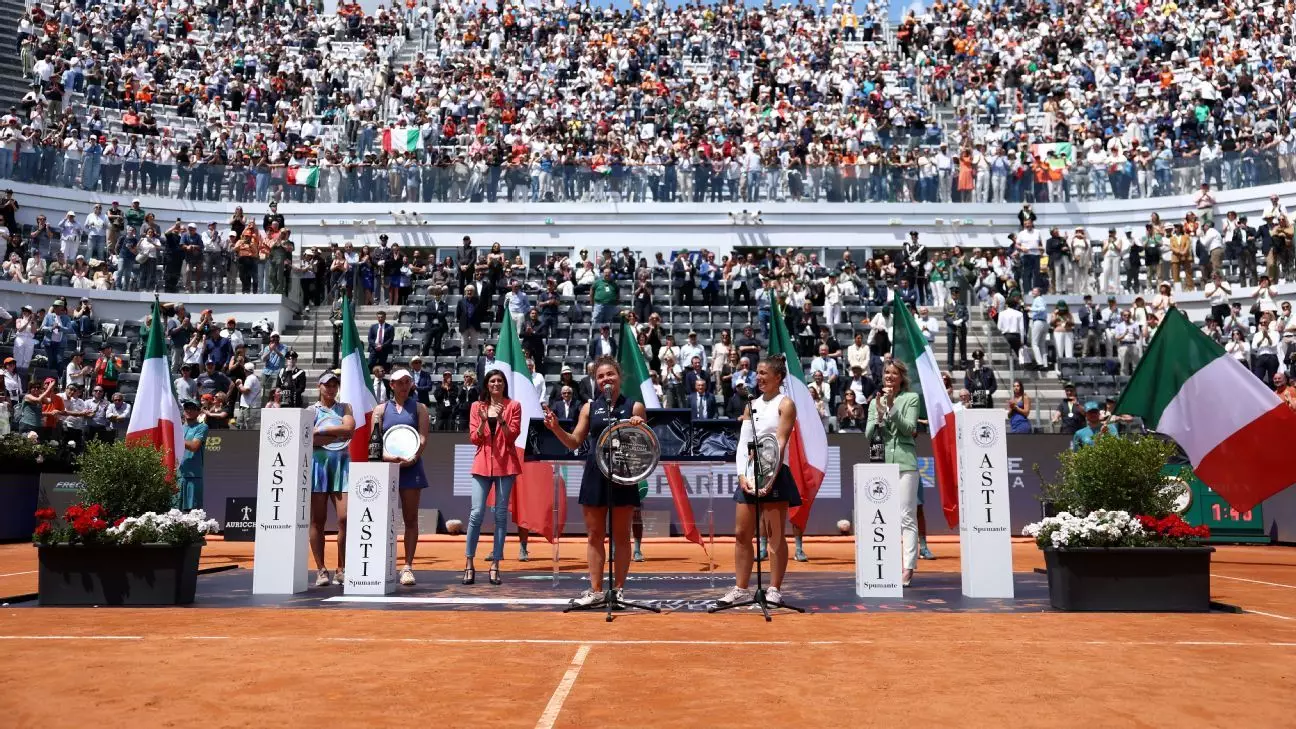Italy has long had a rich sporting heritage, but never before has the nation surged forth in the world of tennis as it is doing now. Under the leadership of the Italian Tennis and Padel Federation President Angelo Binaghi, the landscape of Italian tennis appears primed for unprecedented growth. The ascension of stars like Jannik Sinner and Jasmine Paolini has galvanized not only a fanbase but also a fresh wave of aspirations that reach beyond simple national pride. With both the Davis Cup and Billie Jean King Cup titles in the bag, the Italian tennis community is not merely celebrating past glories; they are setting their sights on a future that could redefine the hierarchy of the sport entirely.
However, Binaghi’s vision extends well beyond fleeting championships. His audacious ambition is to elevate the Italian Open to the status of a fifth Grand Slam tournament—a monumental shift that would disrupt a century-old tradition. “In what other part of society is there a monopoly that lasts for more than 100 years?” he asks, challenging the long-standing dominance of the current four Grand Slam events. This question reverberates through the world of tennis, inviting provocative discourse on the very structure and future prospects of the sport.
The Building Blocks of Ambition
It isn’t just the likes of Sinner and Paolini propelling this movement. Names such as Lorenzo Musetti and Tyra Caterina Grant are emerging from the shadows, indicating that Italy might not just be witnessing a moment but potentially entering a golden age. The investment in young talent is a critical component of Binaghi’s vision, with an emphasis on cultivating a sustainable ecosystem where talent flourishes. The recent extension of the ATP Finals in Turin through 2030 and the upcoming Davis Cup Final 8 in Bologna underscores Italy’s increasing significance in global tennis.
While reaching for Slams is an audacious goal, the Italian Open—one of the premier Masters Series events—has grown rapidly thanks to structural modifications and increased engagement. Therefore, the idea of eliminating competitors like the Madrid Open to create a more substantial Italian event is not merely wishful thinking; it’s a calculated strategy to redefine tennis’s competitive landscape.
Infrastructure Enhancements: A Step Toward Greatness
Italy isn’t just focusing on talent; tangible improvements to infrastructure are in the works as well. Plans for a retractable roof over the iconic Campo Centrale stadium aim to enhance the tournament experience while attracting more top-tier players. At a hefty cost of 60 million euros, this roof is projected to be ready for the 2028 tournament and promises to increase capacity, allowing more fans to engage with the sport. It underscores the seriousness with which the Italian Tennis Federation is approaching its goal of becoming a tennis powerhouse.
Moreover, the expansion of the tournament grounds from 12 to 20 hectares not only makes logistics more manageable but also enriches the aesthetic and emotional experience of the event. The addition of the Stadio dei Marmi as a major venue with multiple courts exemplifies a growing commitment to not just hosting tournaments but creating an environment where spectators feel a deep connection to the game.
Challenges and the Path Ahead
Nevertheless, venturing into uncharted territories comes with its set of challenges. The quest for a fifth Grand Slam will not be met without resistance from established entities. The inertia of long-standing traditions is powerful, and any shift towards disrupting the current order will require not just ambition but also diplomacy. There’s much at stake, and Binaghi himself acknowledged the need to “be attentive on the international market” to leverage opportunities effectively.
While the Italian Open is witnessing expansion, establishing its reputation as a Grand Slam will depend on myriad factors, including player participation, global media rights, and sponsors. The evolving tennis ecosystem requires a multifaceted approach that goes beyond just the physical attributes of venues; it calls for a rethinking of how we engage fans, showcase talent, and celebrate the sport itself.
Italy’s ambition in tennis is louder than a mere echo; it’s a clarion call for change that invites players, fans, and stakeholders to re-examine the landscape of the game. If Binaghi and his team can translate this vision into reality, we may not only witness the rise of Italy in tennis but the birth of a new era that reshapes the very essence of the sport.


Leave a Reply